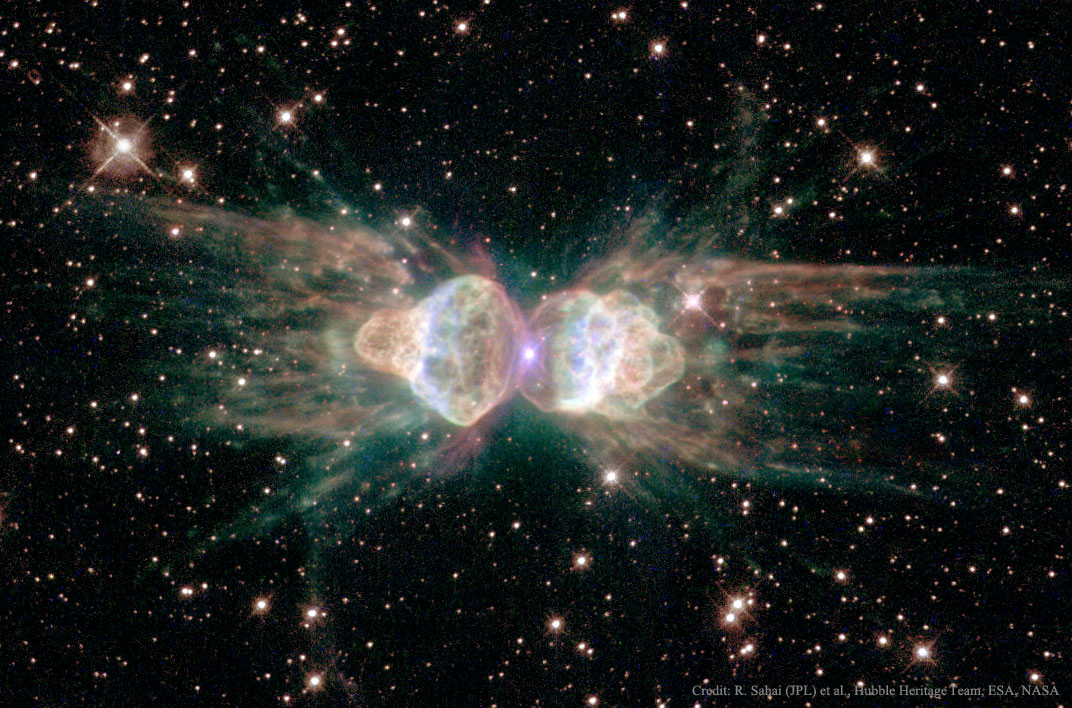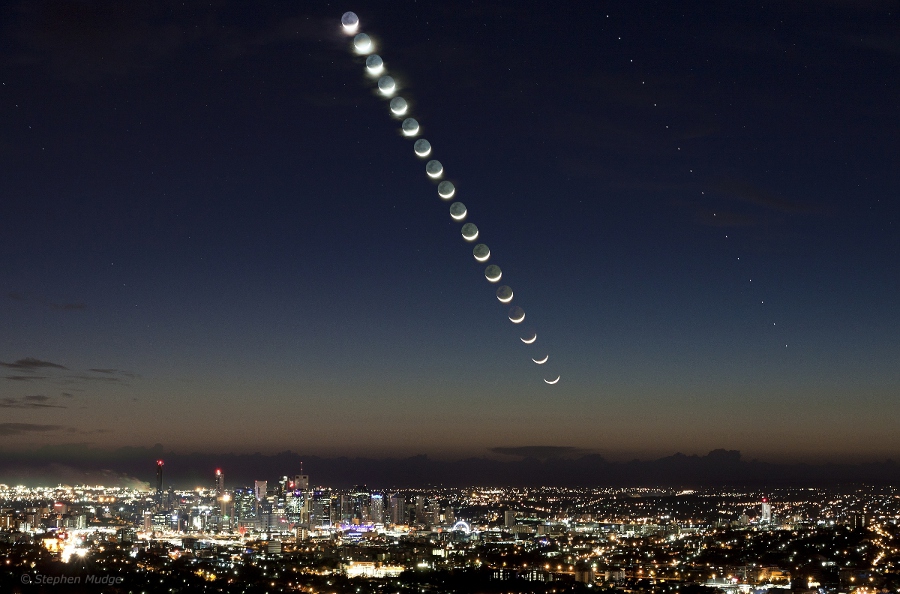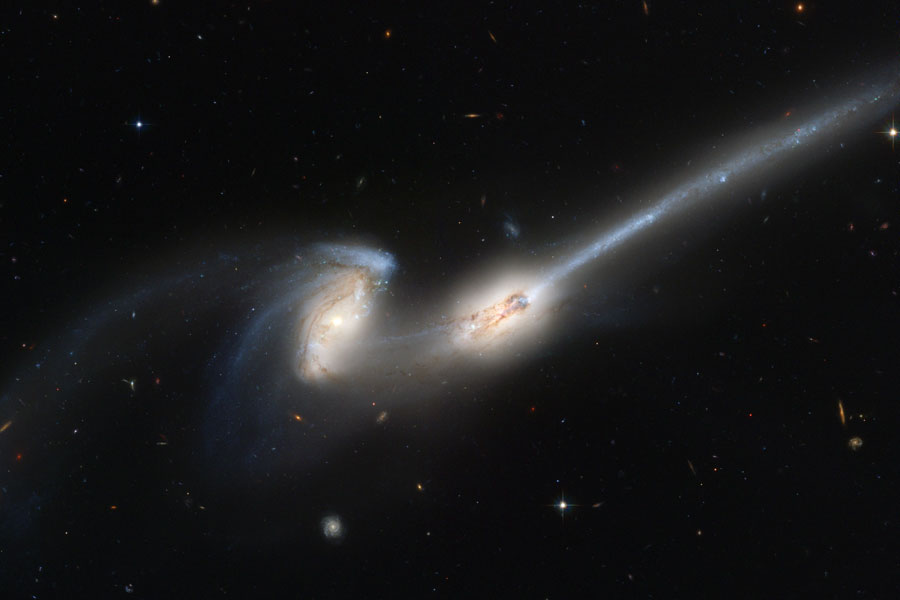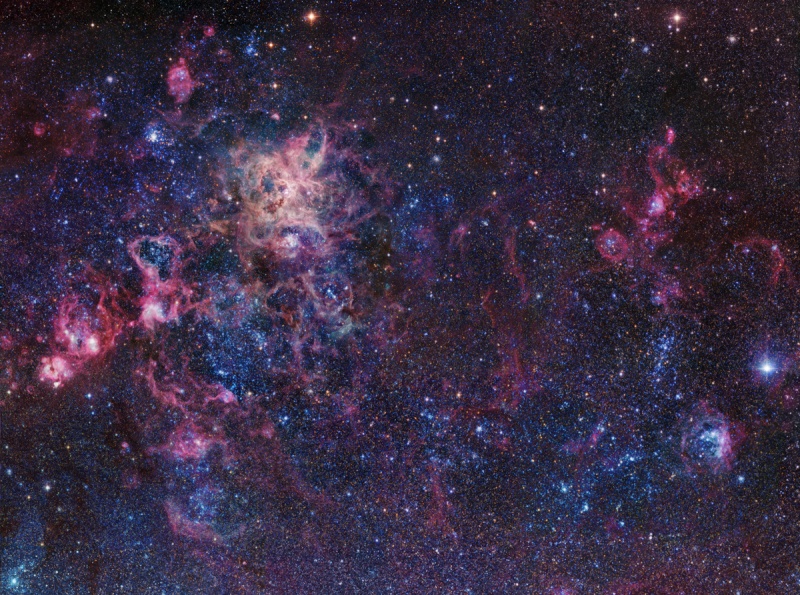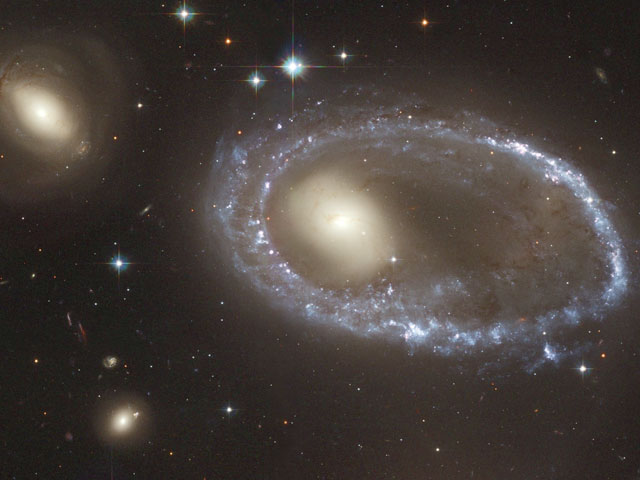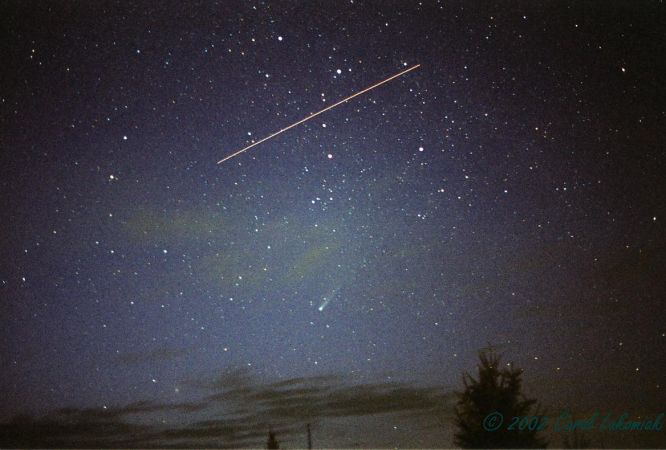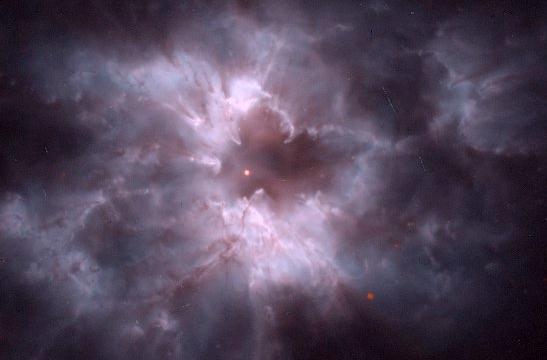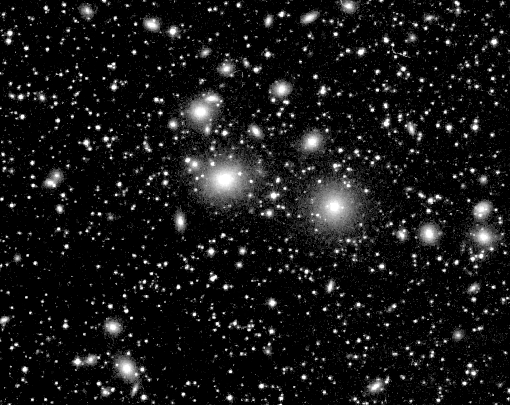| << Previous | Index | Next >> |
2015 Why isn't this ant a big sphere? Planetary nebula Mz3 is being cast off by a star similar to our Sun that is, surely, round. Why then would the gas that is streaming away create an ant-shaped nebula that is distinctly not round? Clues might include the high 1000-kilometer per second speed of the expelled gas, the light-year long length of the structure, and the magnetism of the star visible above at the nebula's center. One possible answer is that Mz3 is hiding a second, dimmer star that orbits close in to the bright star. A competing hypothesis holds that the central star's own spin and magnetic field are channeling the gas. Since the central star appears to be so similar to our own Sun, astronomers hope that increased understanding of the history of this giant space ant can provide useful insight into the likely future of our own Sun and Earth.
2014
2013 Our solar system's miasma of incandescent plasma, the Sun may look a little scary here. The picture is a composite of 25 images recorded in extreme ultraviolet light by the orbiting Solar Dynamics Observatory between April 16, 2012 and April 15, 2013. The particular wavelength of light, 171 angstroms, shows emission from highly ionized iron atoms in the solar corona at a characteristic temperatures of about 600,000 kelvins (about 1 million degrees F). Girdling both sides of the equator during approach to maximum in the 11-year solar cycle, the solar active regions are laced with bright loops and arcs along magnetic field lines. Of course, a more familiar visible light view would show the bright active regions as groups of dark sunspots. Three years of Solar Dynamics Observatory images are compressed into this short video.
2012 Last week Mercury wandered far to the west of the Sun. As the solar system's innermost planet neared its greatest elongation or greatest angle from the Sun (for this apparition about 27 degrees) it was joined by an old crescent Moon. The conjunction was an engaging sight for early morning risers in the southern hemisphere. There the pair rose together in predawn skies, climbing high above the horizon along a steeply inclined ecliptic plane. This well composed sequence captures the rising Moon and Mercury above the city lights of Brisbane in Queensland, Australia. A stack of digital images, it consists of an exposure made every 3 minutes beginning at 4:15 am local time on April 19. Mercury's track is at the far right, separated from the Moon's path by about 8 degrees.
2011 A satellite galaxy of our own Milky Way, the Large Magellanic Cloud (LMC) is an alluring sight in dark southern skies and the constellation Dorado. A mere 180,000 light-years distant, the LMC is seen in amazing detail in this very deep 4 frame mosaic of telescopic images, a view that reveals the Milky Way's satellite to have the appearance of a fledgling barred spiral galaxy. The mosaic includes image data taken through a narrow filter that transmits only the red light of hydrogen atoms. Ionized by energetic starlight, a hydrogen atom emits the characteristic red H-alpha light as its single electron is recaptured and transitions to lower energy states. As a result, this mosaic seems spattered with pinkish clouds of hydrogen gas surrounding massive, young stars. Sculpted by the strong stellar winds and ultraviolet radiation, the glowing hydrogen clouds are known as H II (ionized hydrogen) regions. Composed of many overlapping clouds, the sprawling Tarantula Nebula left of center, is by far the LMC's largest star forming region. The Large Magellanic Cloud is about 15,000 light-years across.
2010 Inside the head of this interstellar monster is a star that is slowly destroying it. The monster, on the right, is actually an inanimate pillar of gas and dust that measures over a light year in length. The star, not itself visible through the opaque dust, is bursting out partly by ejecting energetic beams of particles. Similar epic battles are being waged all over the star-forming Carina Nebula. The stars will win in the end, destroying their pillars of creation over the next 100,000 years, and resulting in a new open cluster of stars. The pink dots around the image are newly formed stars that have already been freed from their birth monster. The above image was released last week in commemoration of the Hubble Space Telescopes 20th year of operation. The technical name for the stellar jets are Herbig-Haro objects. How a star creates Herbig-Haro jets is an ongoing topic of research, but it likely involves an accretion disk swirling around a central star. A second impressive Herbig-Haro jet occurs diagonally near the image center.
2009 These two mighty galaxies are pulling each other apart. Known as "The Mice" because they have such long tails, each spiral galaxy has likely already passed through the other. They will probably collide again and again until they coalesce. The long tails are created by the relative difference between gravitational pulls on the near and far parts of each galaxy. Because the distances are so large, the cosmic interaction takes place in slow motion -- over hundreds of millions of years. NGC 4676 lies about 300 million light-years away toward the constellation of Bernice's Hair (Coma Berenices) and are likely members of the Coma Cluster of Galaxies. The above picture was taken with the Hubble Space Telescope's Advanced Camera for Surveys which is more sensitive and images a larger field than previous Hubble cameras. The camera is scheduled to be serviced during the coming flight of Space Shuttle.
2008 The Tarantula Nebula is more than 1,000 light-years in diameter -- a giant star forming region within our neighboring galaxy the Large Magellanic Cloud (LMC). That cosmic arachnid lies at the upper left of this expansive mosiac covering a part of the LMC over 6,000 light-years across. Within the Tarantula (NGC 2070), intense radiation, stellar winds and supernova shocks from the central young cluster of massive stars, cataloged as R136, energize the nebular glow and shape the spidery filaments. Around the Tarantula are other violent star-forming regions with young star clusters, filaments and bubble-shaped clouds. The small but expanding remnant of supernova 1987a, the closest supernova in modern history, is located near the center of the view. The rich field is about as wide as four full moons on the sky, located in the southern constellation Dorado.
2007 The unremarkable star centered in this skyview is Gliese 581, a mere 20 light-years away toward the constellation Libra. But astronomers are now reporting the discovery of a remarkable system of three planets orbiting Gliese 581, including the most earth-like planet found beyond our solar system. Gliese 581 itself is not a sun-like star, though. Classified as a red dwarf, the star is much smaller and colder than the Sun. Still, the smallest planet known to orbit the star is estimated to be five times as massive as Earth with about 1.5 times Earth's diameter. That super-earth orbits once every 13 days, about 14 times closer to its parent star than the Earth-Sun distance. The close-in orbit around the cool star implies a mean surface temperature of between 0 and 40 degrees C - a range over which water would be liquid - and places the planet in the red dwarf's habitable zone.
2006 A crumbling comet will soon pass near the Earth. Comet 73P/Schwassmann-Wachmann 3 is brightening and may even be visible to the unaided eye when the fragmented comet zooms past Earth during the middle of next month. Still, the small comet poses no Earth hazard, since it will pass the Earth at about 25 times the distance of the Moon. Exactly how bright Comet Schwassman-Wachmann 3 will get is unknown. It is even possible, althought unlikely, that debris from the comet will have spread out enough to cause a notable meteor shower. Pictured above, Fragment B of Comet Schwassman-Wachmann 3 was photographed two nights ago by a 8.2-meter Very Large Telescope in Chile. Visible to the lower right of the large B fragment are many mini-comets that have broken off and now orbit the Sun separately. Each mini-comet itself sheds gas and dust and so appears to have its own hazy coma. The comet will pass closest to the Sun on June 7.
2005 What goes there across the plains of Mars? A dust devil. For the first time, definitive movies of the famous spinning dust towers have been created from ground level. The robot rover Spirit has now imaged several dust devils from its hillside perch just within the past two months. Each image in the above sequence was taken about 20 seconds apart. Inspection of the digitally resized images show the passing dust devil raising Martian dust so thick that it casts a shadow. The new dust devil movies have been made possible by a new hybrid interaction system where the robot Spirit on Mars takes many images and humans on Earth inspect thumbnails and decide which full resolution images to send back.
2004 How could a galaxy become shaped like a ring? The rim of the blue galaxy pictured on the right is an immense ring-like structure 150,000 light years in diameter composed of newly formed, extremely bright, massive stars. That galaxy, AM 0644-741, is known as a ring galaxy and was caused by an immense galaxy collision. When galaxies collide, they pass through each other -- their individual stars rarely come into contact. The ring-like shape is the result of the gravitational disruption caused by an entire small intruder galaxy passing through a large one. When this happens, interstellar gas and dust become condensed, causing a wave of star formation to move out from the impact point like a ripple across the surface of a pond. The intruder galaxy has since moved out of the frame taken by the Hubble Space Telescope and released to commemorate last Saturday's fourteenth anniversary of Hubble's launch. Ring galaxy AM 0644-741 lies about 300 million light years away.
2003 This reconstructed digital portrait of our planet is reminiscent of the Apollo-era pictures of the "big blue marble" Earth from space. To create it, researchers at Goddard Space Flight Center's Laboratory for Atmospheres combined data from a Geostationary Operational Environmental Satellite (GOES), the Sea-viewing Wide Field-of-view Sensor (SeaWiFS), and the Polar Orbiting Environmental Satellites (POES) with a USGS elevation model of Earth's topography. Stunningly detailed, the planet's western hemisphere is cast so that heavy vegetation is green and sparse vegetation is yellow, while the heights of mountains and depths of valleys have been exaggerated by 50 times to make vertical relief visible. Hurricane Linda is the dramatic storm off North America's west coast. And what about the Moon? The lunar image was reconstructed from GOES data and artistically rescaled for this visualization.
2002 Still catching the Sun's rays, the International Space Station (ISS) cruises across the early evening sky above Tomahawk, Wisconsin, USA. Recorded on April 9 around 9 pm CDT in a 30 second exposure, the sunlit space station traced this bright streak moving east (right) through the constellation Cassiopeia. Below lies Comet Ikeya-Zhang sporting a visible tail. But while this photogenic comet is now fading from view, the ISS will be getting brighter. Hours after this picture was taken, the Space Shuttle Atlantis docked with the ISS, bringing another structure to add to the growing orbital outpost.
2001
2000 Subtle and delicate in appearance, these are filaments of shocked interstellar gas -- part of the expanding blast wave from a violent stellar explosion. Recorded in November 1997 with the Wide Field and Planetary Camera 2 onboard the Hubble Space Telescope, the picture is a closeup of a supernova remnant known as the Cygnus Loop. The nearly edge-on view shows a small portion of the immense shock front moving toward the top of the frame at about 170 kilometers per second while glowing in light emitted by atoms of excited Hydrogen gas. Not just another pretty picture, this particular image has provided some dramatic scientific results. In 1999, researchers used it to substantially revise downward widely accepted estimates of distance and age for this classic supernova remnant. Now determined to lie only 1,440 light-years away, the Cygnus Loop is thought to have been expanding for 5 - 10 thousand years.
1999 Here lie 526,230,881 of the brightest stars known. The US Naval Observatory has deployed their monster Precision Measuring Machine to digitize photographic plates covering the whole sky and creating the above map. Yellow corresponds to 150,000 stars per square degree, while dark blue corresponds to only 500 stars per square degree. (For comparison, the Full Moon takes up about 1/4 of a square degree.) The most striking feature on this whole sky projection is the central disk of our Milky Way Galaxy, which stretches across the middle. Dark dust lanes are evident there by the great number of stars they obscure. The two bright spots seen south of the Milky Way's disk are the neighboring Magellanic Cloud galaxies. Anyone can order a free copy of this data, but not everyone can fit data from all 526,230,881 stars on their hard-drive.
1998 Like a butterfly, a white dwarf star begins its life by casting off a cocoon that enclosed its former self. In this analogy, however, the Sun would be a caterpillar and the ejected shell of gas would become the prettiest of all! The above cocoon, the planetary nebula designated NGC 2440, contains one of the hottest white dwarf stars known. The white dwarf can be seen as the bright dot near the photo's center. Our Sun will eventually become a "white dwarf butterfly", but not for another 5 billion years. The above false color image and was post-processed by F. Hamilton.
1997 Here is one of the largest objects that anyone will ever see on the sky. Each of the fuzzy blobs in the above picture is a galaxy, together making up the Perseus Cluster, one of the closest clusters of galaxies. We view the cluster through the foreground of faint stars in our own Milky Way Galaxy. It takes light roughly 300 million years to get here from there, so we only see this cluster as it existed during the age of the dinosaurs. Also known as Abell 426, the center of Perseus cluster is a prodigious source of X-ray radiation, and so helps astronomers study how clusters formed and how gas and dark matter interact. The Perseus Cluster of Galaxies is part of the Pisces-Perseus supercluster of galaxies, which spans over 15 degrees and contains over 1000 galaxies.
1996
| << Previous | Index | Next >> |
